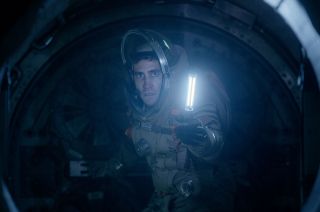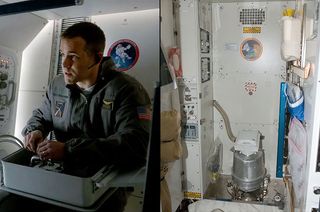'Life' Imitating Life Off Earth: Space Station History 'Easter Eggs' in Sci-fi Thriller

In space, everyone can see your homages.
"Life," Sony Pictures' new science fiction thriller featuring Jake Gyllenhaal, Rebecca Ferguson and Ryan Reynolds, has been described as a modern day "Alien" set on board the International Space Station. The movie, which opened in theaters on Friday (March 24), follows a space crew as they encounter an emerging life form, not unlike the basic plot of the 1979 Ridley Scott classic.
And that's not by accident. ['Life' Movie Brings Terrifying Space Thrills (Photo Gallery)]
"It references practically all of those great movies... all [the way] from 'The Thing' to 'Alien' to '2001' to 'Solaris,'" said "Life" director Daniel Espinosa.
But given his movie's setting — a real-life, if somewhat re-imagined space station, rather than a fictional starfreighter or interplanetary spaceship — Espinosa was also inspired by and included nods ("easter eggs") to spaceflight history. The Chile-born, Sweden-based director said he even hid a reference to the first Swede in space, Christer Fuglesang, though would not reveal what or where it is.
"The movie has tons of small secrets," said Espinosa in an interview with collectSPACE.com. "It has a little reference to Fuglesang, who is our great champion. But there were other astronauts who were part of the process, so look at the movie intently, it is out there — but it's secret!"
What follows are five references in "Life" to space station and space exploration history, which may or may not have been intentional, followed a few bonus easter eggs spotted on a first viewing of the film. (Warning: Spoilers ahead.)
Get the Space.com Newsletter
Breaking space news, the latest updates on rocket launches, skywatching events and more!
Wait, what space station are we on?
As noted from the start, "Life" is set on the International Space Station, the orbital laboratory that has been crewed by more than 250 people over the course of more than 16 years (the statistics are also stated accurately in the film). And sure enough, in addition to countless mentions of the "ISS," the movie's six crewmates (portrayed by Gyllenhaal, Ferguson, Reynolds, Ariyon Bakare, Hiroyuki Sanada and Olga Dihovichnaya) also call out some of the names of the real space station''s modules, including Unity, Tranquility, Kibo and Zvezda.
But space history enthusiasts would not be at fault if they become briefly confused about what space staton the crew is on during several key sequences in "Life."
In the movie, the astronauts control and monitor the space station's systems from a large, submarine-like console that is unlike anything aboard the International Space Station. But it does bear a more than passing resemblance to the Apollo Telescope Mount (ATM) console that was on board Skylab, the United States' first space station.
"On the front of the ATM console were the many switches and indicators that were used to control electrical power to each telescope, to open and close experiment doors, and to change the operational pace of each instrument," wrote John Eddy in a 1979 NASA history. "Dials and counters displayed instrument readiness conditions and, as on any camera, showed how many frames remained in each film magazine."
The Skylab ATM console also incorporated TV screens for monitoring live events, similar to how the control station is configured in "Life."
In another of the film's scenes, Reynolds' character, Rory Adams, complains, "Sixteen steps to fix a shower? I am an astronaut, not a gym teacher." Any number of steps would be impressive, given that the ISS does not have a shower. But Skylab did...

That's how you go to the bathroom in space
As Adams (Reynolds) works on the (non-existent) shower, he sits inside a very convincing replica of the International Space Station's Waste and Hygiene Compartment (WHC), complete with a suction-powered toilet and even a spoof of an already humorous decal affixed inside the real facility in space. [How to Pee in Space (and What to Do If the Toilet Breaks)]
The authentic emblem features a spacewalking astronaut, holding a roll of toilet paper, heading for an old-fashioned, outdoor bathroom. The insignia is inscribed, "International Space Station Orbital Outhouse Team."
The "Life" version also features a spacewalker, but rather than floating, he appears to have launched from Earth by gas — or rather, flatulence — powered propulsion.
The WHC is one of several true-to-life features that can be spotted inside the "Life" space station. Other equipment and components that were somewhat accurately recreated for the movie include a microgravity science glovebox and the multi-window Cupola (though the latter is considerably larger than its on-orbit inspiration).
Rodent research
The "Life" cast is small: other than the six astronauts and a few supporting characters on Earth, the only other life in "Life" are the Martian creature (named "Calvin" through a student contest, another detail that rings true to how things have been named on the station) and a white lab rat.
The rodent is not out of place on the space station. Since 2014, NASA and CASIS, the Center for the Advancement of Science in Space, which manages the science on board the U.S. National Laboratory section of the orbital outpost, have been launching mice as part of an ongoing series of rodent research studies focused on investigating different biological aspects of microgravity exposure.
Like the rat in "Life," the actual rodent residents are on an ill-fated mission; they are euthanized as part of the needs of the research. In the movie, the rat's end — as Calvin's first victim — is considerably less humane.

Drowning on a spacewalk
While on the subject of casualties, the commander of the station in "Life," Russian cosmonaut Ekaterina Golovkina (Dihovichnaya), meets her own end by drowning while on a spacewalk, a scenario that might have been deemed too unbelievable even for a movie had it not almost occurred to a real astronaut four years ago.
On July 16, 2013, Italian astronaut Luca Parmitano of the European Space Agency (ESA) was just over an hour into a planned six and a half hour extravehicular activity (EVA) outside of the International Space Station when his helmet began to fill with water. Fortunately, Parmitano was able to make it back to the airlock in time to safely get inside.
"The moment when they removed my helmet, that's when we found out that about 1.5 liters of water had collected inside the helmet. Now the helmet is pretty small, so a liter and a half of water is quite a bit; it really felt like I was a goldfish in a fishbowl, on the wrong side," Parmitano later recalled at an ESA conference.
In "Life," Golovkina's helmet is flooded because Calvin is compressing her spacesuit's coolant system. Parmitano's helmet filled up with water due to contamination clogging a filter.
Where there's (oxygen) smoke, there's fire
Despite its ability to survive longer than most creatures in the vacuum of space, Calvin, like other carbon-based life forms, is said to require oxygen. So when the station's life support starts to fail, David Jordan (Gyllenhaal) realizes he and Miranda North (Ferguson) can lure out the Martian by using oxygen candles.
A backup to the station's primary oxygen supply, oxygen candles are not an invention for the movie. Each solid-fuel oxygen generator (SFOG) aboard the actual space station contains enough lithium perchlorate to produce oxygen for one person to last a full day.
The candles do not create a flame — or are not supposed to under normal operation — and unlike in "Life" are not handheld or a source of light.
And whereas the threat from the oxygen candle in the film is a close encounter with Calvin, the SFOG (Vika or TGK, as referred to by Roscosmos, the Russian federal space corporation) was the source of an emergency on board a space station when one of the canisters caught fire.
The 90-second blaze occurred aboard the former Russian space station Mir on Feb. 24, 1997. It caused only minor damage to the orbiting outpost, but the crew were exposed to heavy smoke and had to don goggles and masks as a result.
Continue reading at collectSPACE for more "Life" space station history easter eggs.
Follow collectSPACE.com on Facebook and on Twitter at @collectSPACE. Copyright 2017 collectSPACE.com. All rights reserved.
Join our Space Forums to keep talking space on the latest missions, night sky and more! And if you have a news tip, correction or comment, let us know at: community@space.com.

Robert Pearlman is a space historian, journalist and the founder and editor of collectSPACE.com, an online publication and community devoted to space history with a particular focus on how and where space exploration intersects with pop culture. Pearlman is also a contributing writer for Space.com and co-author of "Space Stations: The Art, Science, and Reality of Working in Space” published by Smithsonian Books in 2018. He previously developed online content for the National Space Society and Apollo 11 moonwalker Buzz Aldrin, helped establish the space tourism company Space Adventures and currently serves on the History Committee of the American Astronautical Society, the advisory committee for The Mars Generation and leadership board of For All Moonkind. In 2009, he was inducted into the U.S. Space Camp Hall of Fame in Huntsville, Alabama. In 2021, he was honored by the American Astronautical Society with the Ordway Award for Sustained Excellence in Spaceflight History.

